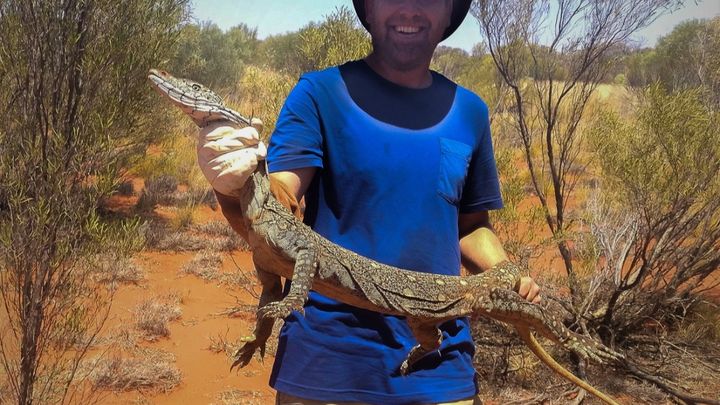
Help us learn about Australia's largest lizard
Some of you will have heard of the perentie - Australia's largest lizard and king of the red centre. Measuring up to 2.5 m in length, our research team is studying these fascinating and secretive animals in central Australia to learn more about their wild behaviours and the role they play in the Outback.
In many ecosystems around the world, large mammals play critical ecological roles. For example, they are the apex predators in many parts of the world and their influence flows throughout food webs. However, Australia is unique. With its mammals consisting mostly of a radiation of small to medium marsupials, Australia doesn’t contain large, native mammals such as lions, tigers and bears that fulfil the top predator niches. So instead, this crucial role is often filled by large reptiles. The perentie is the continent’s largest lizard and the native apex predator in the desert, but very little is known about these secretive animals.
How much do perenties move? What do they eat? How long do they live? When do they breed and where do they lay their eggs? How do the eggs survive 9 months in such a hot and dry environment? These are all questions that we don't have answers to and are the starting point for our research: our work looks to uncover as much as possible about perentie biology and ecology. Our study involves radio-tracking 20 perenties in the southwest Northern Territory over 3+ years. In this time, we want to track individual animal movements, learn about how daily temperatures, rainfall, and other environmental factors may affect their movement and behaviour. Further, by observing animals over several years, we hope to be able to identify gravid females and document nesting in the wild for the first time.
Have a look at this short video showing what some of our jobs in the field look like!
Footage shot by our talented volunteers.
Our work has the potential to substantially broaden the knowledge of this cryptic apex predator and the role it plays in regulating Australia’s arid ecosystem. A fundamental understanding of the species' biology can help inform conservation action and captive husbandry of Australian goannas.
Unfortunately, our study area is very remote and tracking the animals manually every day requires a lot of outback driving. This means that $10,000 AUD goes into covering fuel expenses during the field season. Ultimately, we hope to switch to using drones with radio-tracking abilities to reduce our fuel consumption and increase the amount of data we can collect. The findings of the study will be published in scientific journals and shared via SciComm for wildlife documentaries and educational videos.
Can you help us by pitching in a few dollars? They can make the difference in helping us fund our new tracking technology and keep this project running. Your donation would mean the world to us and these lizards.
Thank you,
the Perentie Project Team
In many ecosystems around the world, large mammals play critical ecological roles. For example, they are the apex predators in many parts of the world and their influence flows throughout food webs. However, Australia is unique. With its mammals consisting mostly of a radiation of small to medium marsupials, Australia doesn’t contain large, native mammals such as lions, tigers and bears that fulfil the top predator niches. So instead, this crucial role is often filled by large reptiles. The perentie is the continent’s largest lizard and the native apex predator in the desert, but very little is known about these secretive animals.
How much do perenties move? What do they eat? How long do they live? When do they breed and where do they lay their eggs? How do the eggs survive 9 months in such a hot and dry environment? These are all questions that we don't have answers to and are the starting point for our research: our work looks to uncover as much as possible about perentie biology and ecology. Our study involves radio-tracking 20 perenties in the southwest Northern Territory over 3+ years. In this time, we want to track individual animal movements, learn about how daily temperatures, rainfall, and other environmental factors may affect their movement and behaviour. Further, by observing animals over several years, we hope to be able to identify gravid females and document nesting in the wild for the first time.
Have a look at this short video showing what some of our jobs in the field look like!
Footage shot by our talented volunteers.
Our work has the potential to substantially broaden the knowledge of this cryptic apex predator and the role it plays in regulating Australia’s arid ecosystem. A fundamental understanding of the species' biology can help inform conservation action and captive husbandry of Australian goannas.
Unfortunately, our study area is very remote and tracking the animals manually every day requires a lot of outback driving. This means that $10,000 AUD goes into covering fuel expenses during the field season. Ultimately, we hope to switch to using drones with radio-tracking abilities to reduce our fuel consumption and increase the amount of data we can collect. The findings of the study will be published in scientific journals and shared via SciComm for wildlife documentaries and educational videos.
Can you help us by pitching in a few dollars? They can make the difference in helping us fund our new tracking technology and keep this project running. Your donation would mean the world to us and these lizards.
Thank you,
the Perentie Project Team
 Organizer
Organizer
Kari Soennichsen
Organizer
Western, NT